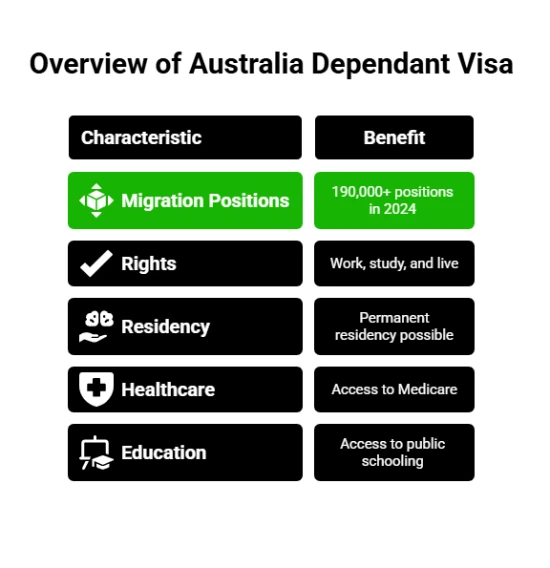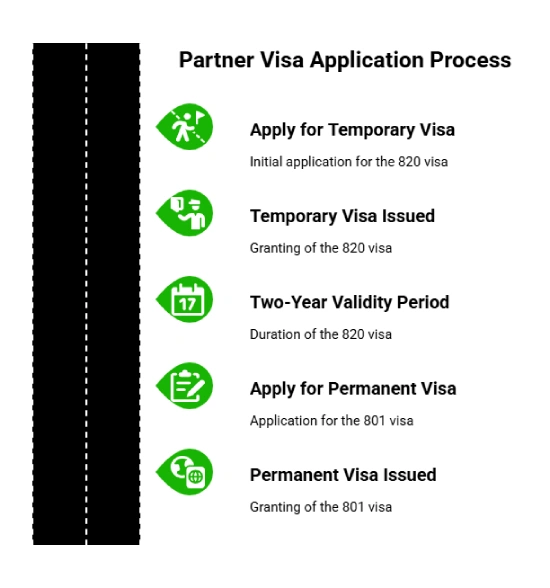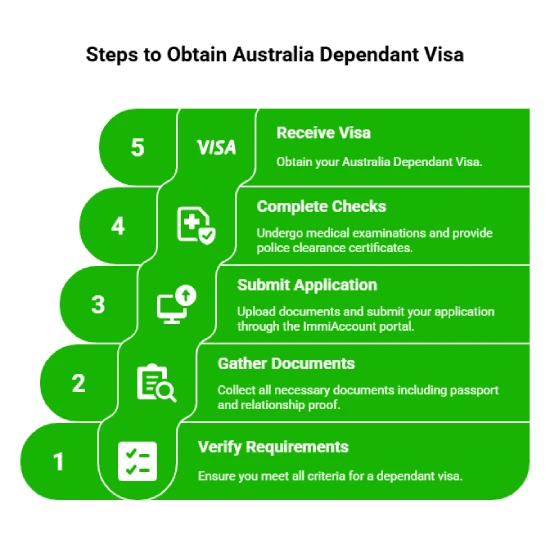Why Apply for an Australia Dependant Visa?
The Australia Dependant Visa provides a way for family members of Australian citizens along with permanent residents and temporary visa holders to join their relatives in Australia. The visa presents an opportunity for spouses together with children and dependent relatives to live and work and study in Australia. This visa serves as the best choice for people who want to reunite with their family members in Australia while experiencing the advantages of living in one of the most diverse and welcoming countries.
- Family members and dependents can apply for more than 190,000 migration positions across Australia during 2024.
- Dependent partners together with children obtain rights to work and study as well as live in Australia.
- Eligible visa holders gain access to Australia's public health care system known as Medicare.
- Children benefit from family-oriented policies which provide them access to public schooling options.
- Certain visa categories provide opportunities for eligible individuals to obtain Australia PR or permanent residency status.

*Want guidance to apply for Australia Dependant Visa? Sign up with Y-Axis for comprehensive support with the process.
What is an Australia Dependant Visa?
Australia Dependant Visas serve people who maintain family connections with holders of particular Australian visa categories. This includes spouses, de facto partners, children, and other dependents of Australian citizens, permanent residents, or temporary visa holders. The visa allows dependants to live in Australia and, in most cases, grants them permission to work and study. This visa is part of Australia's effort to facilitate family reunification while supporting its diverse workforce.
Types of Australia Dependant Visas
Australia provides several subclasses under its Dependant Visa which allows dependants to accompany primary visa holders to Australia. The visa subclasses enable dependants to live, work and study in Australia based on their specific subclass eligibility.
The popular Australia Dependant Visas are given below.
- Subclass 500 – Student Dependant Visa
- Subclass 482/186/494 – Skilled Worker Dependant Visa
- Subclass 820/801 – Partner Visa
- Subclass 100/309 – Offshore Partner Visa
- Subclass 103 – Parent Visa
- Subclass 116 – Carer Visa
- Subclass 114 – Aged Dependent Relative Visa

Subclass 500 – Student Dependant Visa
Students with Subclass 500 student visas can bring their family members including spouses and children into Australia through this visa. The visa enables dependants of students to reside in Australia and engage in work and academic activities during the primary applicant's study duration.
Partners receive unrestricted work permissions and children can pursue their education in schools. The visa duration matches the primary applicant's student visa period which could last up to 5 years based on the course duration.
Subclass 482/186/494 – Skilled Worker Dependant Visa
Subclass 186 (Employer Nomination Scheme) and Subclass 494 (Skilled Employer-Sponsored Regional) permits enable their dependent family members to apply for the Skilled Worker Dependant visa. Dependents who receive this visa get permission to live and work in Australia while also having access to public services including Medicare as well as study opportunities.
This visa maintains the same duration as the main applicant's visa for up to five years or until the main visa holder's work contract reaches its end.
Subclass 820/801 – Partner Visa
The Subclass 820 is a temporary Partner visa and the Subclass 801 functions as a permanent partner visa. This visa enables the spouse or de facto partner of an Australian citizen, permanent resident or eligible New Zealand citizen to reside in Australia.
The application process begins with a temporary visa issuance which transitions into permanent status after a standard two-year period. The temporary visa (820) remains valid for two years before the permanent visa (801) becomes available.|

Subclass 100/309 – Offshore Partner Visa
The visa provides access to people who start their application process from locations beyond Australia's borders. The visa enables Australian citizens and permanent residents to bring their spouses or de facto partners to live in Australia. The onshore partner visa operates in the same way because the applicant receives a temporary visa before they become eligible for permanent residency through meeting set standards.
The temporary visa remains valid for 2 years so applicants can request the permanent Subclass 100 visa.
Other Family-Based Dependant Visas
The other types of family based dependant visas are given below.
|
Visa Type |
Description |
|
Subclass 103 – Parent Visa |
The visa permits parents to live with their children who hold Australian citizenship or permanent resident status. This immigration pathway provides family reunion opportunities for parents of Australian citizens and residents who seek permanent residency in Australia. The applicants must prove their financial dependency on their children. The validity is permanent, and the processing time can vary from 6 to 10 years due to high demand. |
|
Subclass 116 – Carer Visa |
The Subclass 116 Carer Visa applies to people who must deliver personal care to a family member with medical conditions needing assistance. Through this visa the applicant gets permission to reside in Australia while delivering 24/7 care. Applicants can apply from within or outside Australia. The visa grants permanent status which lets the carer stay and work in Australia without any time restrictions. |
|
Subclass 114 – Aged Dependent Relative Visa |
Australian citizens or PR holders can sponsor elderly family members who depend financially on them for entry through this visa. The applicant requires sponsorship because they lack self-care ability and depend fully on the sponsoring child for assistance. This visa grants permanent status which lets the applicant reside in Australia throughout their eligibility period. |
Benefits of Australia Dependant Visa
The benefits of Australia Dependant Visa are given below.
- Eligible visa holders enable their dependants to obtain work rights within the Australian territory.
- Australian educational institutions allow children together with adult dependants to take classes there.
- The healthcare system of Australia is accessible to qualified dependants.
- The Partner Visa (subclass 820/801) represents an example of dependent visas which provide permanent residency pathways.
- Families can maintain their unity in Australia through this arrangement which establishes a secure and caring living environment.
Eligibility Criteria for Dependant Visa
To be eligible for an Australia Dependant Visa, applicants must meet the eligibility criteria given below.
- The dependant must provide documents that verify their relationship to the primary visa holder including marriage certificates for spouses and birth certificates for children.
- The primary visa holder needs to demonstrate their financial capability to support the dependant through appropriate documentation.
- All applicants need to provide health assessments along with police clearance certificates as part of their application.
- The standard requirement for dependent children is that they must be younger than 18 years old while full-time students can remain dependents until they reach 23 years of age.
Australia Dependant Visa Requirements
The documents required to apply for Australia Dependant Visa are given below.
- The applicant must submit a valid passport as their official identification document.
- The applicant must prove their connection to the main visa holder through official documents such as marriage certificates or birth certificates.
- The applicant must provide financial documentation that includes bank statements and salary slips to demonstrate their financial support.
- All dependants need to undergo health examinations as part of the application process.
- Applicants must provide police clearance certificates from the country where they currently reside.
- The applicant needs to provide evidence showing their accommodation arrangements in Australia.
Australia Dependant Visa Application Process for UAE Residents
The detailed procedure to apply for the Australia Dependant Visa is given below.
Step 1: You need to verify that you fulfil all requirements to obtain a dependant visa by demonstrating your connection with the main applicant who holds the primary visa.
Step 2: You need to gather all essential documents which include your passport along with relationship proof and financial evidence and health checks.
Step 3: Using the ImmiAccount portal you should establish an account before submitting your visa application by uploading all required documents.
Step 4: As part of the application process you need to complete medical examinations and provide police clearance certificates.
Step 5: Receive your Australia Dependant Visa.

Australia Dependant Visa Processing Time
Detailed information about the processing time for Australia Dependant Visa is given below.
|
Visa Type |
Estimated Processing Time |
|
Student Dependant Visa (Subclass 500) |
2–4 months |
|
Partner Visa (Subclass 820/801) |
12–24 months |
|
Skilled Worker Dependant (Subclass 482/186/494) |
3–6 months |
|
Offshore Partner Visa (Subclass 100/309) |
12–24 months |
|
Parent Visa (Subclass 103) |
6–10 years |
|
Carer Visa (Subclass 116) |
Varies |
|
Aged Dependent Relative Visa (Subclass 114) |
Varies |
Australia Dependant Visa Fees
The fees for the various types of Australia Dependant Visa are given in the table below.
|
Visa Type |
Fee (AUD) |
|
Subclass 500 – Student Dependant Visa |
AUD 1,680–2,680 |
|
Subclass 820/801 – Partner Visa |
AUD 7,000–8,850 |
|
Subclass 482/186/494 – Skilled Worker Dependant Visa |
AUD 1,680–2,400 |
|
AUD 7,000–8,850 |
|
|
Subclass 103 – Parent Visa |
AUD 4,300–7,000 |
|
AUD 3,000–4,500 |
|
|
Subclass 114 – Aged Dependent Relative Visa |
AUD 3,000–4,500 |
Can a Dependant Work in Australia?
Yes, dependants of specific visa holders can work in Australia, but the work rights are influences by the primary visa holder's visa subclass. For example:
|
Visa Type |
Work Rights for Dependants |
|
Skilled Worker Visa (Subclass 186 and Subclass 494) |
Full-time work rights for dependants |
|
Student Visa (Subclass 500) |
Limited work rights (maximum 40 hours per fortnight during studies) |
|
Partner Visa (Subclass 820/801) |
Full work rights |
|
Full-time work rights for dependants |
Can a Dependant Study in Australia?
Yes, dependants below the age of 18 can study in Australia. The Australian education system grants permission to dependents who are younger than 18 years to study in the country. Adult dependants possess the ability to pursue short-term courses but they need to obtain a Student Visa for full-time study based on the course type and duration.
How Can Y-Axis Help You?
Y-Axis provides complete support for individuals residing in the UAE who wish to apply for the Australia Dependant Visa. Our services enable the following support:
- We conduct eligibility evaluations to determine your visa qualification status.
- We prepare your documents and establish a checklist to simplify the application process.
- We handle your visa application submission through the ImmiAccount portal.
- Our team provides interview preparation services for dependant applicants who require it.
- We provide comprehensive support throughout the visa approval process until you receive your visa grant status.
Looking for Inspiration
Explore what Global Citizens have to say about Y-Axis in shaping their future
Frequently Asked Questions
